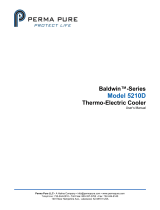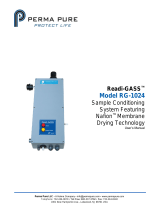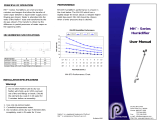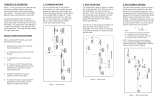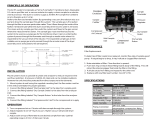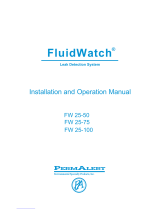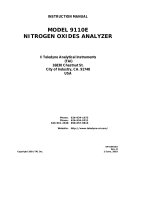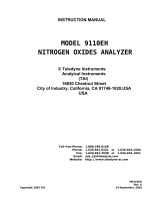Page is loading ...

Perma Pure LLC • A Halma Company • info@permapure.com • www.permapure.com
Telephone: 732-244-0010 • Toll Free: 800-337-3762 • Fax: 732-244-8140
1001 New Hampshire Ave., Lakewood, NJ 08701 USA
Baldwin™-Series
Model 20410D
Thermo-Electric Cooler
User’s Manual

Model 20410D User’s Manual
Doc. SE-MAN-052 REV 00
Page 2 of 25
©2017 Perma Pure LLC. All rights reserved. Specifications subject to change.
CONTENTS
3. Introduction
6. Specifications
6. Connections
7. Important Safety Warnings
8. Installation
8. Hardware required for installation
8. Mounting
8. Connections
8. Sample and Drain
9. Board Connections
13. LED Summary
14. Start-up
15. Troubleshooting and Maintenance Guide
19. Replacement Parts
20. Appendix A: Cooler Drawings
20. A1: Model 20410D dimensional drawing
21. A2: Impinger diagram
22. Appendix B: Sample Conditioning System Drawings
22. B1: Flow schematic
23. Appendix C: Conversion Table
25. Appendix D: Warranty and Disclaimer

Model 20410D User’s Manual
Doc. SE-MAN-052 REV 00
Page 3 of 25
©2017 Perma Pure LLC. All rights reserved. Specifications subject to change.
UNPACKING
Perma Pure has made every effort to ship you a high-quality product that has been thoroughly inspected and
tested. It has been carefully packed to ensure that it arrives at your facility in good condition. Even though every
effort has been made to prevent damage during the transportation process, damage can occur by the carrier. This
is out of control of Perma Pure and is the responsibility of the carrier to ensure that your equipment arrives intact
and undamaged.
Inspect outside packaging. If there is any visible damage, inform the carrier at the time of deliver. This
inspection is important! Once the package is signed for, responsibility for any visible damage then
transfers to the consignee.
Unpack your equipment. Visually inspect the outside of your equipment for any damage. If there is any
damage, contact the carrier immediately. Generally, a carrier must be notified within 24 hours of the delivery
to make a hidden damage claim.
Items in the carton include:
(1) Model 20410D thermo-electric cooler
(1) User’s Manual
Optional glass impingers will ship separately.
If any of the above parts are missing or damaged, call the helpline at (800) 337-3762 ext-145.
INTRODUCTION
Thank you for purchasing this product from Perma Pure LLC. This manual has been assembled so that it can
answer all questions regarding operation. Please keep the operators manual near the equipment for future
reference. There may also be optional equipment available that was not ordered at the time of original purchase,
which may be described and/or illustrated in this manual.
If you still have any questions regarding your equipment’s operation, available options or technical support,
please contact your purchasing dealer or contact Perma Pure directly.
Perma Pure LLC Tel: 732-244-0010
1001 New Hampshire Ave. Tel: 800-337-3762 (toll free US)
Lakewood, NJ 08701 Fax: 732-244-8140
website: www.permapure.com e-mail: [email protected]
This equipment is to be installed and operated by trained personnel, with sufficient command of the English
language to clearly understand the instructions and safety warnings.

Model 20410D User’s Manual
Doc. SE-MAN-052 REV 00
Page 4 of 25
©2017 Perma Pure LLC. All rights reserved. Specifications subject to change.
PRINCIPLE OF OPERATION
One of the natural products of combustion (and
other processes) is significant amounts of water
in the form of vapor. Most measurement
processes require this water to be removed for
proper measurement and/or reliability of the
system. The cooler rapidly lowers the
temperature of the sample stream in the impinger
to just above the freezing point of the water,
thereby forcing water vapor to condense. Once
condensed, it is collected and removed. The
20410D is a thermoelectric cooler, which utilizes
TECs (also called Peltier elements) to provide
active cooling. The cooler may include a passive
stage, where the cold block is thermally mated
directly to the heat sink. The Peltier element is a
key element to this type of cooler. When
powered, one side becomes cold and the other
side becomes hot. The control system monitors
the coldest point on the heat transfer block, and
holds it to just above freezing, preventing the sample
stream from icing up. The control system reacts to
variations in temperature at the heat transfer block, maintaining the set point as the load or ambient conditions
vary.
LIMITATIONS:
There are limitations to what a thermoelectric cooler can do. The Peltier elements can only move so much heat. If
more heat is applied to the channel than the element can move for a given set point, the element will be
overwhelmed and the temperature will rise above the set point. The Peltier element generates a differential
temperature for a given voltage and load. As the ambient temperature rises, the hot side heat sink rises with it.
Should ambient conditions become too hot the element will no longer be able to maintain the set point for the
applied load. Ambient conditions should be within specifications for proper operational characteristics. As
mentioned above, a cooler lowers the temperature of the sample stream to just above freezing. This process may
drop out other constituents of the sample stream with the water, some which may impact your measurements.
Perma Pure Provides Nafion-based sample conditioning systems which prevent loss of water soluble analyses
using a permeation method for sample drying.
Figure 1: Thermo-electric element (Peltier)

Model 20410D User’s Manual
Doc. SE-MAN-052 REV 00
Page 5 of 25
©2017 Perma Pure LLC. All rights reserved. Specifications subject to change.
KEY COMPONENTS OF A THERMO-ELECTRIC COOLER:
1) Peltier Element: When DC voltage is applied to the Peltier element, one side of the element becomes
cold, and the other hot. This heating and cooling effect at the junction of dissimilar metals is referred to as
the Peltier effect, named after the physicist who discovered it in 1834. The Peltier elements used here are
very powerful, and if not properly mated to a thermal sink will get extremely hot very quickly. DO NOT
POWER these elements without proper connection to a heat sink! You may get burned, and will damage
or destroy the element!
2) Heat Sink: The Peltier elements generate a significant amount of waste heat when in operation. This
heat is conducted into a heat sink to be removed into the ambient environment by forced convection.
3) Heat Sink Fan: The above mentioned forced convection.
4) Heat Transfer Block: This is the mechanical and thermal interface between the cold side of the Peltier
elements and the walls of the impinger. The heat transfer block provides a conductive path and
mechanical interface between the long cylindrical impinger and the rectangular Peltier elements.
5) Impinger: Interface between the sample stream and the heat transfer block. Water vapor condenses
along the outer wall and collects in the bottom for extraction. The sample stream travels through the
impinger, so corrosion resistance must be considered.
6)
Power Supply: AC to regulated DC to provide sufficient amperage for the Peltier elements configuration.
Peltier elements have a very specific
power to performance curve.
Performance can be adversely
affected by supplying too much
power. The power supply provided is
factory adjusted, and should not be
altered!
7) Control Thermistors: Measures
temperature of the heat transfer
block at the Peltier element interface
for feedback to control electronics.
This is the temperature displayed,
and is the coldest point on the heat
transfer block.
8) Control Electronics: Regulates
power supplied to Peltier elements to
maintain a set temperature. The
control electronics provides Pulse
Width Modulated (PWM) power to
the Peltier elements, regulated by a
control loop.
9) Peristaltic Pump (not covered
here): Removes condensate from
the impinger without creating a path
for outside air to enter the sample stream.
Figure 2: Heat Exchanger, Impinger and Heat Sink

Model 20410D User’s Manual
Doc. SE-MAN-052 REV 00
Page 6 of 25
©2017 Perma Pure LLC. All rights reserved. Specifications subject to change.
PHYSICAL DESCRIPTION
Single (Series) or Dual (Parallel) stream system
2 x 10” heat exchangers connected in series or parallel; actively cooled to the temperature set point
LCD temperature display
Dimensions: 14.5” x 11” x 10.5” HWD (37 x 28 x 26.5 cm)
Weight: 35 lbs (16 kg)
SPECIFICATIONS
Sample gas flow range Up to 11 LPM (Up to 23.3 SCFH)
Avg. inlet dew point at rated flow 20% H2O (60°C DP) @ 8 LPM
Maximum cooling rate 440 BTU/hr (464 kJ/hr)
Maximum inlet sample temp. 400°F (205°C) for SS or glass impingers
280°F (138°C) for Kynar™ impingers
Maximum inlet pressure 15 psig (1 bar;760 mmHg)
Maximum pressure drop <+1 in H2O
Ambient temperature range 33-104°F (0.6-40°C)
Outlet sample gas dew point 39°F (4°C)
Voltage 115 OR 230 VAC (Verify before energizing
equipment) 50/60 Hz
Power supply 600 Watt
Cooling down time Less than 6 minutes
CONNECTIONS
Sample gas inlet: Kynar, 3/8” tube compression fitting
Sample gas outlet: Kynar, 1/4” tube compression fitting
Drain tubing connection: Kynar, x ¼” barbed tube fitting
An automatic condensate drain, dual-head peristaltic drain pump is recommend (not included) for
water removal, Perma Pure part number 3KPB-003; size 17 tubing.
Always use factory supplied fittings; Perma Pure cannot warrant against damage to the Peltier elements or heat
exchangers if our fittings are not used.

Model 20410D User’s Manual
Doc. SE-MAN-052 REV 00
Page 7 of 25
©2017 Perma Pure LLC. All rights reserved. Specifications subject to change.
IMPORTANT SAFETY WARNINGS
Please be sure to review the following basic safety procedures. These procedures represent the MINIMUM
requirements to operate the equipment safely. It is the ultimate responsibility of the operator to ensure
that proper safety practices are utilized at the point of operation.
NEVER attempt to operate this equipment in an explosive or otherwise hazardous area.
NEVER exceed any specified rating for the equipment. Voltage, temperature and pressure ratings must be
closely observed and not exceeded. Voltage rating of the equipment MUST match the rating on the data
label. Please make sure that it matches before powering up the equipment.
This equipment is NOT designed to be used in an explosive environment.
This equipment is NOT designed to operate in a wet environment.
Condensate is potentially dangerous. NEVER handle drain lines, impingers or any other item that may
have come into contact with the gas stream or any hazardous material, without adequate personal protective
equipment. ALWAYS assume that any liquid present is hazardous.
Sample gas is potentially dangerous. A leak test is recommended at initial startup and as often as
necessary to maintain a safe working environment around the equipment. The gas stream exhaust must exit
away from all personnel to prevent dangerous exposure.
NEVER operate the equipment with any part of the enclosure unsecured. All operating doors and
covers must be in place and secured prior to operation. Electrical current may be present behind covers or
doors, even if tools are not necessary to access these components.
NEVER attempt service on this equipment without first disconnecting all energy sources. Repair of this
equipment should only be done by properly trained personnel that are familiar with the potential risks
involved with servicing of the equipment.
NEVER replace fuses with types other than the sample specification of type and current. Do not bypass this
or any other safety device.
NEVER operate this equipment if it is visibly damaged or the possibility exists that it may have been
damaged.
The use of components that have not been purchased through an authorized Perma Pure dealer or directly
from Perma Pure may compromise the safety of the operator. Additionally, use of non-authorized
components may change the operating characteristics of this equipment. Any changes to the equipment, that
modify its operation in any way, are dangerous, and are strictly prohibited.
Read the entire operating manual before attempting to set up or operate the equipment.
Please heed all warning labels that are on the equipment. They are there to remind you of possible
hazardous conditions.
Verify the integrity of any mechanical and/or electrical connections that are made to the unit.
Verify that the unit is connected to the proper rated power for the system
Verify that the unit is plumbed properly to operate effectively

Model 20410D User’s Manual
Doc. SE-MAN-052 REV 00
Page 8 of 25
©2017 Perma Pure LLC. All rights reserved. Specifications subject to change.
INSTALLATION
Hardware required for installation
(4) ¼-20 mounting screws
For stainless steel sample lines, 2 inches of 3/8” Teflon tube
Peristaltic drain pump, dual head
Mounting
The Classic Model 20410D Thermo-Electric Cooler should be installed away from heat sources in a well
vented area.
NOTE: The operational stability of the cooler dew point is influenced by the stability of the
ambient temperature.
For proper operation, the ambient temperature cannot exceed 40°C (104°F). At, or close to the maximum
ambient temperature, the cooler will not be able to control the temperature to reduce the dew point of the
sample gas to the 4°C set point. This will result in compromised operation and water slip or carryover,
possibly into the analyzer. Also, at or near this temperature, the cooler will be running “full on” and Peltier
life will be greatly reduced.
CONNECTIONS
Sample and Drain
1. Connect the sample inlet to the 3/8” tube fitting shown in figure 3.
NOTE: If using heated stainless steel sample line, add 2 inches of Teflon tubing at the heat exchanger
inlet fitting, and connecting it to the heated line. This isolates the heated line from the heat exchanger
and prevents excessive heating of the heat exchanger, possibly overloading the cooler.
2. Connect the sample outlet to the 1/4” tube fitting shown in figure 3.
3. Connect the peristaltic pumps to the ¼” barbed tube fitting at the bottom of the impinger.
NOTE: Do not reduce the size of the condensate tubing since doing so restricts water flow resulting in
water carryover into the sample.
Figure 3: Typical connections

Model 20410D User’s Manual
Doc. SE-MAN-052 REV 00
Page 9 of 25
©2017 Perma Pure LLC. All rights reserved. Specifications subject to change.
BOARD CONNECTIONS

Model 20410D User’s Manual
Doc. SE-MAN-052 REV 00
Page 10 of 25
©2017 Perma Pure LLC. All rights reserved. Specifications subject to change.
AC side (right side)
JP1: AC line in for accessory control.
JP2: Fused power out from JP1, currently heatsink fan.
JP3: Fused power out from JP1
JP4: Fused pump relay for Channel 2. Relay applies power to circuit when temperature is
below “ready” temperature. Circuit will open when temperature is above the ready
temperature. This avoids passing vapor exceeding the “ready temperature” dew point.
JP4 and JP5 operate independently of each other.
JP5: Fused pump relay for Channel 1. Relay applies power to the circuit when temperature is
below “ready” temperature. Circuit will open when temperature is above the ready
temperature. This avoids passing vapor exceeding the “ready temperature” dew point.
JP4 and JP5 operate independently of each other.
JP6-L Channel 2 alarm relay. Isolated relay which can be wired Normally Open (N.O.) or
Normally Closed (N.C.). JP6 and JP7 operate independently of each other. A sensor
failure (short or open) will trip the relay.
JP7: Channel 1 alarm relay. Isolated relay which can be wired NC or NO (normally open or
normally closed). JP6 and JP7 operate independently of each other. NOTE: The board is
incorrectly physically labeled.
FUSE1: 10Amp fuse between JP1 and JP2 and JP3
FUSE2: 10 Amp fuse between JP1 and JP4 and JP5 (pump relay controlled)

Model 20410D User’s Manual
Doc. SE-MAN-052 REV 00
Page 11 of 25
©2017 Perma Pure LLC. All rights reserved. Specifications subject to change.
DC Side(left side):
JP8: Not Used
JP9: EPROM flash. For factory use only.
JP10: Outputs for Peltier element channel 2. Pulse width modulated (PWM) with DC input voltage.
JP11: Outputs for Peltier element channel 1. Pulse width modulated (PWM) with DC input voltage.
JP12: 12VDC regulated out for fans. 2 Circuits, steady on and thermostatically controlled provided.
Thermostat control is for enclosure fan only
JP13: Slip sensor inputs. When resistive threshold is exceeded, pump relays open. Settings are
configurable via software.
JP14: Analog out, 0-3VDC. 2 channels are available. Each output can be configured to telemeter CH1
temp, CH2 temp, or TC temp, via manufacturer’s configuration software at time of purchase.
0VDC and 3VDC temperatures (for scaling) are selectable via configuration software.
JP15: Temperature sensor inputs for CH1 and CH2 thermistors and Type K thermocouple. NJTC MUST
be enabled via software. (Negative lead wire is red)
JP16: RS485 output. Not supported at this time.
JP17: Interlock inputs. When enabled in software, opening the interlock circuit disables the pump on
that channel. That is, the pump will not run unless the circuit is closed.
JP18: Expansion port. Not supported at this time.
JP19: RS485 bias and termination. Not supported at this time.

Model 20410D User’s Manual
Doc. SE-MAN-052 REV 00
Page 12 of 25
©2017 Perma Pure LLC. All rights reserved. Specifications subject to change.
BASIC OPERATION
Your cooler comes from the factory ready to go, preset to operate at 4°C, and to close the sample pump relays at
10°C. Closing the pump relays illuminates the READY status LED, near the temperature display. See the
interconnection diagram for a typical installation that includes water slip sensing, using cooler controlled pump
relays, interlock input and alarm relays. Your cooler can be operated without using any of these on-board
features.
CONTROLLER:
This cooler is controlled by a digital control board.
Throughout this manual, channel 1 refers to the left channel when facing the display, and channel 2 to the right.
This board regulates power to the Peltier elements to maintain the set point temperature regardless of the thermal
load on the channel (within the specified ranges). The board is capable of independently controlling two separate
channels. The board provides a pulsed width modulated power output to the Peltier elements as determined by a
temperature control loop.
In addition, this board includes fused sample pump relays, alarm relays, 0-3V analog output, New Jersey
thermocouple input and output, and slip sensor electronics.
This controller is digitally controlled and configured using a PC via USB and proprietary software.
THE DISPLAY
The display operation varies depending on as shipped configuration. When the unit powers on, it will briefly
display R-XX (r-01, r-02, etc.). This is the revision of the control software loaded into the on-board memory.

Model 20410D User’s Manual
Doc. SE-MAN-052 REV 00
Page 13 of 25
©2017 Perma Pure LLC. All rights reserved. Specifications subject to change.
LED SUMMARY
ForaDualChannelcooler:
1) Numeric Display: Four digit LED display can show temperature in degrees Celsius of CH1, CH2, NJTC,
or toggle between CH1 and CH2.
2) Status LED’s: Indicate operational status of the system.
a. DISPLAY (Display state): GREEN Indicates which channel is being displayed. Flashing
indicates dwelling on that channel, solid indicates toggling between channels, both solid indicates
that NJTC is displayed.
b. FAIL (Failure): RED indicates that the controller has detected an internal system failure.
c. SLIP: GREEN indicates that the Water Slip sensor (if installed) has NOT detected water in the
sample stream. GREEN indicates that the slip controller has not disabled the sample pump(s).
d. READY: GREEN indicates the system has reached its cold ready point and has closed the pump
relays.
3) DISPLAY SELECT Button: Sets the display state. Pushing this button will toggle the display between
Dwell (flashing) CH1, Dwell CH2, Dwell (two solids) NJTC. The controller will not respond to features that
are not enabled. For example, if a NJTC is not enabled, the unit will not allow NJTC display as an option,
it will instead display the revision status. Enabling features in software that are not physically installed
may cause unexpected / unpredictable results.
Status LED’s
Temperature
Display

Model 20410D User’s Manual
Doc. SE-MAN-052 REV 00
Page 14 of 25
©2017 Perma Pure LLC. All rights reserved. Specifications subject to change.
START-UP
1. Verify AC power matches operating voltage that is specified on serial number data label.
2. Plug power cord into a properly grounded main circuit. Green “Slip” LED will come on.
3. Wait for the green “Ready” LED light to come on. This will indicate the impinger temperature is below
10°C and the sample gas flow can begin.
4. Afterwards the factory set-point of +4°C (41°F) will be reached.
The SLIP Green LED is always on unless;
Moisture is detected by the water slip sensor
There is a malfunction (e.g. Shorted water slip sensor leads or a defective relay)

Model 20410D User’s Manual
Doc. SE-MAN-052 REV 00
Page 15 of 25
©2017 Perma Pure LLC. All rights reserved. Specifications subject to change.
TROUBLESHOOTING AND MAINTENANCE GUIDE
Troubleshooting and repair should only be attempted by qualified personnel;
Review Safety Warnings Page for more complete details of potential hazards
Inside the enclosure there are lethal AC voltages, 15VDC power at 12 amps, as well as exposed rotating fan
blades and other potentially hazardous components.
ALWAYS USE CAUTION! DEENERGIZE EQUIPMENT PRIOR TO ATTEMPING SERVICE!
The status board will indicate what the on-board computer thinks is happening.
Verify that the unit has commanded the response before going in to verifying hardware. For example, verify the
board indicates that the pump relay is closed before physically pulling the relay.
Peltier Elements
Troubleshooting Peltier elements can be difficult at the part level without specialized equipment. A conventional
Ohm Meter will not provide useful information. Peltier failure or degradation can be indicated by
current measurement. The measurement should be made during the first few minutes of start-up. For an 20410D,
the Peltier elements are wired in parallel, with each drawing between 6 and 9 amps. Unit-to-unit variation, such as
exact voltage, wire run length, ambient temperature, and cooler temperature, can generate some variation. This
test can also be performed by placing a DC inductive ammeter around the black or white leads coming off JP10 or
JP11.
12VDC Cooling Fan
There are two regulated outputs for the 12VDC cooling fan, one is thermostatically controlled by the control board.
The 12VDC cooling fan on a 20410D should be wired to the designated 12VDC output of the board. Care should
always be taken to avoid rotating blades!
AC Fan
On the 20410D an AC fan is utilized for heat sink cooling. Care should be taken when troubleshooting this fan.
This fan operates with some authority, and should be taken seriously.

Model 20410D User’s Manual
Doc. SE-MAN-052 REV 00
Page 16 of 25
©2017 Perma Pure LLC. All rights reserved. Specifications subject to change.
Symptom Diagnostic Fix
No LED(s) and no fan. AC power input.
10A DC fuse on Control Board
15A AC Input fuse on Power
Supply
Verify 15VDC at output terminals
on Power Supply
Ensure that AC power is connected.
Replace fuse as necessary.
Verify current draw is not
close to or exceeding fuse
rating
Verify current draw of Peltier
Elements
Replace control board if
Peltier elements test properly
and current is excessive
Replace fuse as necessary.
Verify current draw is not
close to or exceeding fuse
rating
Replace power supply if
current is excessive
If reading lower than 15VDC,
carefully disconnect wiring
and measure voltage
If not 15VDC, within 1.0VDC
adjust and/or replace
defective Power Supply
LED(s) on and heatsink fan
does not run. Check fan for blockage (power
off). Check for power at JP1 (AC
power input, unfused), JP2 (AC
power for fan, fused) on control
board
Verify voltage at terminal JP2 of
control PCB; Should be line
voltage
Clear any blockage, replace fuse or
repair wiring as required
Check fuses on control PCB-
If fuses are good and voltage
is not equal to line voltage,
replace control board.
If fuse1 is blown (open),
disconnect JP2 wiring for
heat sink fan and replace
fuse; Retest; reconnect wiring
if fuse does not blow
If fuse blows again, Fan or
wiring may be defective
F1 on control PCB keeps
blowing. Disconnect JP2 wiring for heat
sink fan; Replace fuse
Energize cooler and see if fuse blows-
Fuse blows-Replace control
PCB
Fuse does not blow-verify
heat sink fan wiring condition
If wiring is good, fan likely
defective

Model 20410D User’s Manual
Doc. SE-MAN-052 REV 00
Page 17 of 25
©2017 Perma Pure LLC. All rights reserved. Specifications subject to change.
Failure LED is on. Thermistor connection JP15 pins
1-4 Ensure proper connection.
Try a good thermistor in place of old
one
Mark wiring and connect to
opposite channels at control
PCB, if failure moves with
change of wiring, thermistor
has failed
If not, board is defective.
Replace as required
Impinger frozen and cooler
indicates ambient
temperature.
Thermistor placement in heat
exchanger block.
Peltier element wiring
Verify placement of thermistor
Trace wiring to ensure wiring
is not shorted to chassis
ground due to pinched wires
caught in covers
Impinger does not reach set
temperature, but is below
ready temperature.
System loading.
Verify Peltier Element current
draw
Ensure system loading is not
exceeding cooler capacity.
Review Specifications
Peltier Elements should draw
between 6 and 9 Amps
Ready LED does not come
on when impinger is below
10°C.
Ready temperature adjustment. Consult Factory
Water carryover in system. Impinger temperature. Should be
below 5°C. Ensure system loading is not
exceeding cooler capacity and
ambient conditions are not exceeding
specifications.
Slip LED does not come on. Water carryover in system.
Water slip sensor connections.
Ensure system loading is not
exceeding cooler capacity and
ambient conditions are not exceeding
specifications.
Ensure that all water slip
sensor connections are
made.
Disconnect sensor; Clean tip
of sensor.
Replace sensor as
necessary.

Model 20410D User’s Manual
Doc. SE-MAN-052 REV 00
Page 18 of 25
©2017 Perma Pure LLC. All rights reserved. Specifications subject to change.
Pump does not start. Ready
and slip LED(s) are on. Pump electrical connections. Ensure proper connections.
Possible defective pump; Measure
voltage at corresponding pump
terminals.
If good, pump motor may be
defective(open)
If bad, fuse may be blown on
board; replace fuse with
pump disconnected,
reenergize and retest. If fuse
blows, board is defective
Reconnect pump, if it blows
pump motor likely defective
(shorted or mechanical
failure)
Possible defective relay coil or relay
contact- Visually check operation
and condition. If O.K., check coil of
relay with ohm meter; if O.K.,
possible bad relay contact; Replace
with known good relay.

Model 20410D User’s Manual
Doc. SE-MAN-052 REV 00
Page 19 of 25
©2017 Perma Pure LLC. All rights reserved. Specifications subject to change.
REPLACEMENT PARTS
Classic Model 20410D
Part No. Description
3CCB-051 Control Board: Dual Channel Board, Control, Cooler, Digital
2FAN-005 Fan: Muffin, 4” x 1”, 12 VDC
2FAN-007 Fan: Muffin, 6” x 1½”, 120 VAC
2FAN-008 Fan: Muffin, 6” x 1½”, 230 VAC
3CXD-022 Impinger: 10" EZ-clean twist-apart Durinert®
3CXD-024 Impinger: 10” NJ, EZ-clean twist-apart Durinert coated
3CXG-002 Impinger: 10” Glass, threaded w/ fittings
3CXK-003 Impinger: 10” Kynar
3CXS-022 Impinger: 10” Stainless Steel, EZ-clean twist-apart
3CXS-024 Impinger: 10” NJ, Stainless Steel, EZ-clean twist-apart
3KPE-004* Peltier Element Kit, 40 mm
1PSD-035* Power Supply,1PSD-008/009 Replacement
103185* Thermistor, Control
* Recommended Spares

Model 20410D User’s Manual
Doc. SE-MAN-052 REV 00
Page 20 of 25
©2017 Perma Pure LLC. All rights reserved. Specifications subject to change.
APPENDIX A: COOLER DRAWINGS
Figure A1: Model 20410D Dimensional
/
